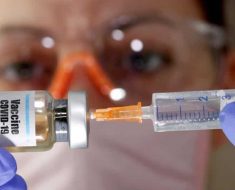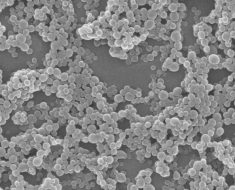In this Special Feature, we inspect the growing links between the lung microbiome and chronic obstructive pulmonary disease (COPD).

COPD refers to a group of conditions, all of which cause difficulty breathing; among them are emphysema and chronic bronchitis.
In the United States, COPD is a relatively common issue, affecting an estimated 1 in 8 people over the age of 45.
Symptoms of COPD tend to worsen over time. Inhalers, medications, and lifestyle changes can ease symptoms significantly, but there is currently no cure.
Although experts know that COPD most commonly results from smoking, researchers are still exploring the changes that occur in the lungs — and some are focusing on the potential role of bacteria.
A world of bacteria
Although we often use the word “microbiome” to refer to the bacteria in our guts, the term encompasses all the microorganisms that live in us and on us.
The gut hosts the largest population of bacteria, but microorganisms abound throughout the human body, including in the lungs.
The science of the microbiome is still in its infancy; it investigates an incredibly complex relationship that has developed over evolutionary time. Our bodies and our environment influence the bacteria within us, and, in turn, bacteria influence the body that they inhabit.
Also, technological difficulties have inhibited our exploration of the microbiome’s influences. Only with the recent advent of next‐generation sequencing technology have we been able to take an accurate snapshot of a given population of bacteria.
As a result, we are only beginning to tease out the associations between our microbial visitors and our physiology in health and disease.
The lung microbiome
Until fairly recently, scientists believed that the lungs were sterile — in other words, microbe-free. This assumption was based on studies using standard culture techniques. These methods do not provide a full picture, though.
As one paper explains, we now know “that less [than] 1% of bacteria collected from soil that are seen under the microscope form colonies on culture, and only 50% of bacteria sampled from human sites […] are recovered by traditional culture techniques.”
One of the earliest studies to characterize the lung microbiome in health and disease appeared in PLOS ONE in 2010. The study compared bacterial populations in the lungs of three groups of adults: people with COPD, individuals with asthma, and healthy people.
The team took samples from three locations in each participant: the nasal cavity, the oropharynx — the middle part of the throat behind the mouth, and the lower airways.
The researchers found that across all three groups, the abundance of microbiota was similar. This overturned the familiar notion of a microbe-free airway. But to the authors, this was no surprise. They write:
“Microbiota are ubiquitous even in the most hostile environments, and it would be extraordinary if the lower airway [was] able to maintain sterility in the presence of high-volume airflow through a damp open communication with the oropharynx.”
Despite similar levels of bacteria throughout the three experimental groups, the scientists did identify significant differences among the populations.
In particular, the groups with lung disease had significantly more Proteobacteria, a major phylum that includes a number of pathogenic genera, such as Haemophilus, Moraxella, and Neisseria.
However, this study only included data from a small number of participants and, although the authors note a strong correlation, they could not “establish causality between the presence of pathogens and airways disease.”
Another issue was that the researchers did not ensure that bacteria from the upper airways did not get carried down into the lower airways during sampling.
Later studies that addressed this issue found that the bacterial populations of the lungs were much more sparse. They also found that the upper and lower airways were home to the same species of bacteria. As the researchers behind one 2011 study write:
“The healthy lung does not contain a consistent, distinct microbiome but instead contains low levels of bacterial sequences largely indistinguishable from upper respiratory flora.”
Lung microbes and COPD
Over the years, researchers have found more and more evidence of a connection between the lung microbiome and COPD symptoms. Although smoking is the primary risk factor for COPD, it seems that bacteria might exacerbate the condition.
In short, experts think that the presence of certain bacteria within the airways sparks inflammation, which, in turn, contributes to the progression of COPD.
One of the leading theories is known as the vicious circle.
Vicious circle theory
This states that tobacco smoke and other chemicals damage the lung’s defenses. These weakened defenses allow pathogenic bacteria to remain in the lower airways, where they thrive.
As these bacteria interact with epithelial and immune cells in the airways, they trigger inflammation as the lungs attempt to combat the infection.
The resulting inflammation further damages the lung’s defenses, helping the bacteria to remain in position, creating a vicious circle of inflammation and increasingly severe lung damage.
If a new species of bacteria arrives in the lungs, this can further worsen symptoms. One paper explains:
“Substantial acute changes in the airway microbiome, for example by introduction of a new strain of a respiratory pathogen, lead to larger inflammatory responses, which present clinically as exacerbations of COPD.”
As mentioned earlier, there is some evidence that in healthy people the bacterial makeup of the microbiome is similar in the upper and lower airways. A small study concluded that this makeup differs only in the quantity of bacteria: There are fewer bacteria the farther down one travels, but the species are similar.
Conversely, people with COPD appear to have different microenvironments within their lungs, with different populations of bacteria residing in different locales. One study compared the lung microbiomes of people with COPD and “healthy” smokers. Among their conclusions, the researchers write:
“Most strikingly, there were significant microanatomic differences in bacterial communities within the same lung of subjects with advanced COPD.“
Species specifics
Looking at associations between changes in the lung microbiome and COPD, one study hinted that bacterial diversity might also play a role. First, they confirmed that “A unique bacterial community is associated with lung tissue from patients with very severe COPD.”
They found that in the lungs of people with severe COPD, Lactobacillus bacteria in particular were more common than in the other groups of people tested.
A study published in 2016 analyzed sputum from 87 people with COPD. They took samples at four points: when symptoms were stable, during exacerbation, 2 weeks after therapy, and 6 weeks after the flare-up.
The scientists identified distinct microbial changes. During exacerbation, microbial diversity was reduced.
Among other changes, there was a slight but not statistically significant increase in the relative abundance of Proteobacteria. They also noted an increase in the relative abundance of bacteria from the genera Moraxella and Haemophilus.
A more recent study, which appeared in Respiratory Research in July 2020, further cements this association. The scientists involved in this research analyzed sputum samples from people with and without COPD.
In participants with COPD, Proteobacteria accounted for 50% of their microbiome. Bacteria from the genera Haemophilus and Moraxella were also more abundant in the sputum of people with COPD.
The most clinically important species of Moraxella is M. catarrhalis, which can cause infections such as sinusitis. Studies have shown that this bacteria can increase airway inflammation, which, in turn, exacerbates the symptoms of COPD.
Importantly, though, the authors of the 2016 study also noted that not all participants with COPD experienced the same fluctuations of bacterial populations; they write, “Specific subgroups of COPD subjects are particularly susceptible to alternation of microbiome during exacerbations.”
The research shows that there may be differences in the microbial populations of lungs affected by COPD and healthy lungs. It also shows that the bacterial makeup might shift during exacerbations — but that these changes do not occur in all individuals.
As is usually the case in microbiome research, we can see that there are relationships between bacteria and disease, that they are complex, and that the meaning of the associations will take some unpicking.
Links to mortality
Some researchers have noted links between specific microbiome changes and mortality in people with COPD.
For instance, the authors of one study concluded that “The microbiome profile of sputum in [acute exacerbations of COPD] is associated with 1-year mortality and may be used to identify subjects with a poor prognosis at the time of hospitalization.”
Specifically, individuals who survived had higher relative abundance of Veillonella, and those who died were more likely to have an increased relative abundance of Staphylococcus. Diversity of the bacterial population also seemed to be important.
The scientists found that “One-year mortality increased significantly with decreasing alpha diversity.” Alpha diversity is a measure of species diversity at a specific location.
Another study followed 253 people with stable COPD for around 4 years. They, too, identified a relationship between sputum microbial populations and mortality. The authors explain:
“Reduced microbiome diversity, associated with Proteobacteria (predominantly Haemophilus) dominance, is associated with […] an increased risk of mortality.”
Future work
As the science of the microbiome moves forward, our understanding of how microbes shape health and disease slowly grows. At this stage, it seems possible that there are differences in the lung microbiomes of people with COPD and those without it.
However, whether there is a causal relationship remains unclear — do the alterations in microbial community cause COPD, or do the symptoms of COPD produce the changes in microbiome?
Some of the stumbling blocks in this line of research are physical and technical challenges. For instance, it is difficult to take samples of bacteria from the lower airway without contamination from the upper airway.
Taking samples from the lower lungs is invasive, and researchers cannot expect people with COPD to undergo these procedures regularly, especially not during flare-ups. Sampling mucus is a more straightforward procedure, but understanding the regional anatomical changes is not possible with this technique.
Of course, the overarching goal of understanding the relationship between COPD and the microbiome is to design better treatments and diagnostics, and we are still some distance from this target. One paper explains:
“To best exploit and translate microbiome findings from COPD into clinical practice, a more detailed understanding of its precise role in COPD phenotypes and outcomes are required.”
With that said, researchers are on the right path. Recent years have seen a flurry of interest in this topic, and our understanding grows rapidly. One paper ends in an upbeat manner, and I will piggyback on its sentiment:
“These are exciting times for microbiome researchers, as the potential to add clinical value remains strong, especially if reproducible and robust biomarkers or therapeutic targets can be identified for COPD.”
Source: Read Full Article





